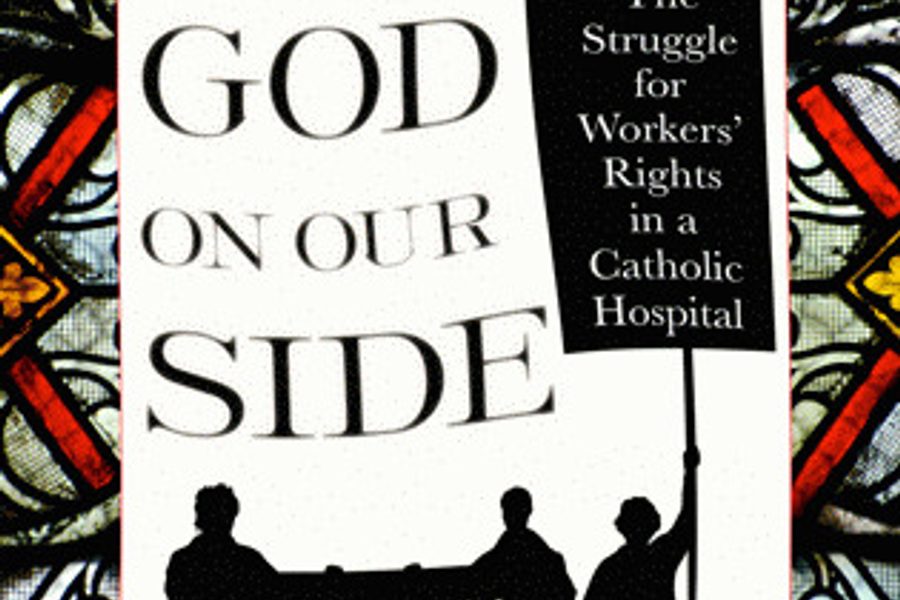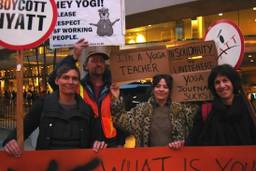
“With God on Our Side” is a very catchy book title. It also appears at first glance to be quite topical because mention of religion so dominates, and distorts many would add, political discussion in this country.
For that reason, curiosity may initially draw the reader’s eye. But the subtitle, “The Struggle for Workers’ Rights in a Catholic Hospital,” gives it all away. This book, published by Cornell University Press next month, is about organized labor and workers.
This is usually where most readers take flight. But that would be a mistake, because it is so much more. Adam Reich, a Ph.D. candidate in sociology at the University of California, Berkeley, has written a very readable and colorful “story of worker leaders” at the largest and most prestigious hospital in the northern California town of Santa Rosa.
The story, however, carries political lessons far beyond the geography of this small-town power struggle. Reich has written a human-interest story about people and why some act so passionately to improve their lives.
He captures the human character and personality of the painfully long seven-year effort that finally succeeded only a few years ago when several hundred workers at Santa Rosa Memorial Hospital (SRMH) voting for representation by the National Union of Healthcare Workers (NUHW).
Reich delves into the very personal aspect of the story, exploring with sensitivity why people under pressure act and react as they do. With significant insight, he also describes how to frame appeals to their consciousness in ways that are specifically and individually crafted.
Worker leaders ignore this advice at their great peril.
For example, Reich points out that the SRMH administration “was able to win the first round of the campaign not only by using standard antiunion strategies but also by appealing to those values of caring and compassion to which the union did not clearly speak.” These concerns are of particular interest to healthcare workers who often declare their keen social consciousness derives from the very nature of their work providing quality patient care.
Reich cites a SRMH union organizer suggesting that “you have to organize people to a vision of good.”
The personal is political
While Reich concedes healthcare workers naturally pay more attention than perhaps other workers to broader social concerns that go beyond simple bread and butter issues, he concludes unions as a whole should also pay attention to compelling moral and social issues and “see themselves less as interest-based organizations and more as values-based organizations.”
Thus, while God is on Our Side has a very clear political message, it is also very much about psychology and sociology and the insights these disciplines offer to explain how and why people act to change their lives. Reich helps us understand why some give up while others persevere against what he describes as “countless obstacles.”
Every union organizer can relate to these observations because they appreciate much better than the general public that organizing campaigns are fundamentally and primarily about people, who they are and want they want. We know organizing a union bears absolutely no resemblance to the vulgar and cynical right-wing misrepresentation and caricature of “big union bosses” seeking more dues money.
Workers, always wary of phony promises and selfish motives, would easily see through this duplicity. In fact, elections are won only if workers support collective bargaining and seek to influence working conditions that improve their lives and, in the case of healthcare workers, improve the lives of their patients.
There is no way around it: To be successful, you must involve and win a majority of workers. The campaign at SRMH reveals just how difficult this can be and describes all the obstacles overcome by the hospital organizing committee.
For example, one of the more dramatic aspects of the story is the surprisingly antagonistic role played by the socially progressive order of nuns that owned SRMH. Reich recounts how the nuns used their esteemed credentials and moral authority to disparage union supporters as “greedy.”
For this review, I asked NUHW organizer Peter Tappeiner about this. “Both management and the sisters painted anyone who supported the union as ‘anti-hospital,’” he told me. “Questioning their commitment to their patients was very hurtful, as many workers at this small community hospital were very proud of their work. This was also very effectively used to demoralize workers, especially when combined with management’s more overt threats and coercion.”
But it wasn’t only management that opposed workers getting a union. Reich describes the actions of one of the nation’s largest unions, Service Employees International Union (SEIU). SEIU acted against the interests of workers by their shameful attempts to delay and thwart the election at SRMH because of their opposition to NUHW, which enjoyed majority support among employees. Eventually, NUHW activists prevailed.
“Through it all, workers gained a very deep understanding of their own power and that of the employer,” Glenn Goldstein emphasized to me. Goldstein was organizing director of NUHW throughout the SRMH campaign. “Union supporters understood, for example, that they not only had to organize co-workers but that they also had to reach out to the community in order to counter the hospital’s powerful, well-funded anti-union media campaign.”
Their efforts paid off.
“As a result of the successful organizing effort at SRMH,” Goldstein added, “we set a precedent for caregivers in other St. Joseph Health System Catholic hospitals which are the largest non-union healthcare employer in California.”
Tappeiner further explained that “we now have the opportunity to negotiate election ground rules so that workers are in a better position to organize elsewhere without the hostile anti-union campaign we faced at SRMH such as supervisory one-on ones, mandatory meetings with management and disparagement of the union.”
If you know, teach; if you don’t know, learn
The thousands of Occupy Movement activists, who so enthusiastically embraced the labor movement and the struggle of the 99%, would greatly benefit by understanding better what actually motivates people to carry on against great odds to improve their lives.
In fact, we all can learn from the author as he examines what happened over the course of a difficult seven years of organizing through personal glimpses of those on both sides of the dispute.
In the end, the workers won union recognition in December 2010. With hopes of more victories to come, it is worth studying this story of labor organizing, perseverance and the triumphs of spirit that carried the majority over the finish line.
Carl Finamore is a delegate to the San Francisco Labor Council, AFL-CIO, and former President (retired), Air Transport Employees, Local Lodge 1781, IAMAW.







